LD端面抽运全固态紫外激光器
- 格式:pdf
- 大小:203.56 KB
- 文档页数:4
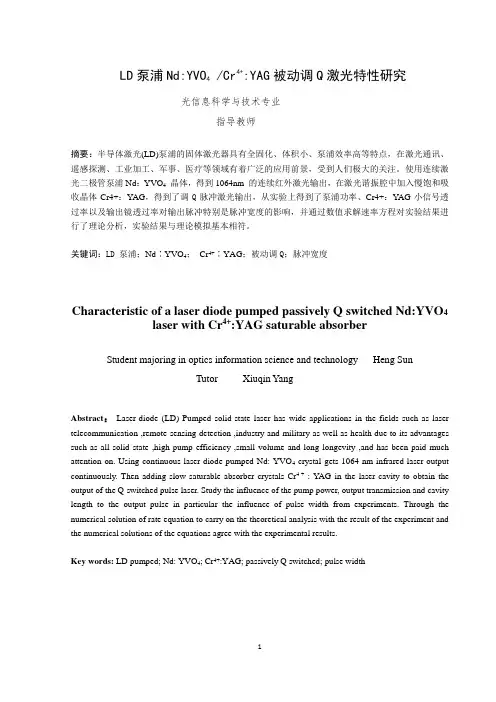
LD泵浦Nd:YVO4 /Cr4+:YAG被动调Q激光特性研究光信息科学与技术专业指导教师摘要:半导体激光(LD)泵浦的固体激光器具有全固化、体积小、泵浦效率高等特点,在激光通讯、遥感探测、工业加工、军事、医疗等领域有着广泛的应用前景,受到人们极大的关注。
使用连续激光二极管泵浦Nd:YVO4晶体,得到1064nm 的连续红外激光输出,在激光谐振腔中加入慢饱和吸收晶体Cr4+:YAG,得到了调Q脉冲激光输出,从实验上得到了泵浦功率、Cr4+:YAG小信号透过率以及输出镜透过率对输出脉冲特别是脉冲宽度的影响,并通过数值求解速率方程对实验结果进行了理论分析,实验结果与理论模拟基本相符。
关键词:LD 泵浦;Nd∶YVO4;Cr4+∶YAG;被动调Q;脉冲宽度Characteristic of a laser diode pumped passively Q switched Nd:YVO4laser with Cr4+:YAG saturable absorberStudent majoring in optics information science and technologyHeng SunTutor Xiuqin YangAbstract:Laser-diode (LD) Pumped solid-state laser has wide applications in the fields such as laser telecommunication ,remote-sensing detection ,industry and military as wellashealthduetoitsadvantagessuchasallsolidstate,high pump efficiency,smallvolumeandlonglongevity,andhasbeen ing continuous laser diode pumped Nd: YVO4crystalgets 1064 nm infrared laser outputcontinuously.Then addingslow saturable absorbercrystals Cr4 + : YAG in the laser cavity to obtain the output of theQ-switched pulse laser. Study the influence of the pump power, output transmission and cavity length to the output pulse in particularthe influence of pulse width from experiments.Through the numerical solution of rate equation to carry on the theoretical analysis with the result of the experiment and thenumericalsolutionsoftheequationsagreewiththeexperimentalresults.Keywords:LDpumped;Nd: YVO4; Cr4+:YAG; passively Q switched;pulse width第一章前言自上世纪六十年代世界上首台激光器发明以来,各类激光器和激光技术得到了迅速的发展,其中固体激光器的发展尤为突出。
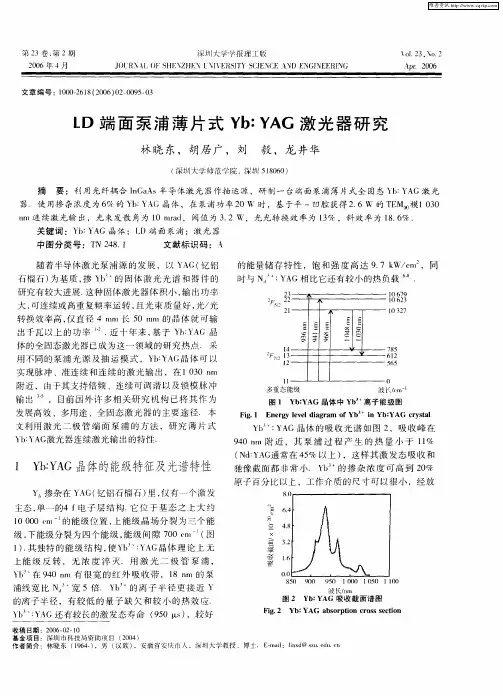
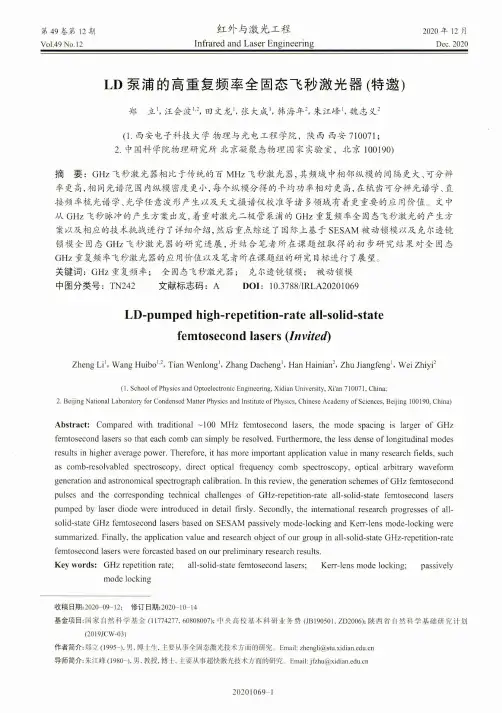
第49卷第12期Vol.49N o.12红外与激光工程Infrared a n d Laser Engineering2020年12月Dec.2020 L D泵浦的高重复频率全固态飞秒激光器(特邀)郑立s汪会波u,田文龙\张大成\韩海年2,朱江峰、魏志义2(1.西安电子科技大学物理与光电工程学院,陕西西安710071;2.中国科学院物理研究所北京凝聚态物理国家实验室,北京100190)摘要:G H z飞秒激光器相比于传统的百M H z飞秒激光器,其频域中相邻纵模的间隔更大、可分辨 率更高,相同光谱范围内纵模密度更小,每个纵模分得的平均功率相对更高,在梳齿可分辨光谱学、直 接频率梳光谱学、光学任意波形产生以及天文摄谱仪校准等诸多领域有着更重要的应用价值。
文中从G H z飞秒脉冲的产生方案出发,着重对激光二极管泵浦的G H z重复频率全固态飞秒激光的产生方 案以及相应的技术挑战进行了详细介绍,然后重点综述了国际上基于S E S A M被动锁模以及克尔透镜 锁模全固态G H z飞秒激光器的研究进展,并结合笔者所在课题组取得的初步研究结果对全固态G H z重复频率飞秒激光器的应用价值以及笔者所在课题组的研究目标进行了展望。
关键词:G H z重复频率;全固态飞秒激光器;克尔透镜锁模;被动锁模中图分类号:T N242 文献标志码:A D O I:10.3788/I R L A20201069LD-pumped high-repetition-rate all-solid-statefemtosecond lasers {Invited)Zheng Li1,W a n g Hu i b o1'2,Tian W e n l o n g1,Zh a n g D a c h e n g1,H a n Hainian2,Z h u Jiangfeng1,W e i Zhiyi2(1. School of Physics and Optoelectronic Engineering, Xidian University, Xi'an 710071, China;2. Beijing National Laboratory for Condensed Matter Physics and Institute of Physics, Chinese Academy o f Sciences, Beijing 100190, China)Abstract:C o m p a r e d with traditional 〜100 M H z femtosecond lasers,the m o d e spacing i s larger of G H z femtosecond lasers so that each c o m b can simply be resolved.Furthermore,the less dense of longitudinal m o d e s results in higher average p o w e r.Therefore,i t has more important application value in m a n y research fields,such as comb-resolvabled spectroscopy,direct optical frequency c o m b spectroscopy,optical arbitrary waveform generation and astronomical spectrograph calibration.In this review,the generation schemes of G H z femtosecond pulses and the corresponding technical challenges of G H z-repetition-rate all-solid-state femtosecond lasersp u m p e d by laser diode were introduced in detail firsly.Secondly,the international research progresses of all-solid-state G H z femtosecond lasers based on S E S A M passively mode-locking and Kerr-lens mode-locking were summarized.Finally,the application value and research object of our group in all-solid-state G H z-repetition-rate femtosecond lasers were forcasted based on our preliminary research results.K e y w o r d s:G H z repetition rate;all-solid-state femtosecond lasers;Kerr-lens m o d e locking;passively m o d e locking收稿日期:2020-09-12;修订日期:2020-10-14基金项目:国家自然科学基金(11774277, 60808007);中央高校基本科研业务费(JB190501,Z D2006);陕西省自然科学基础研究计划(2019JCW-03)作者简介:郑立(1995-),男,博士生,主要从事全固态激光技术方面的研究。
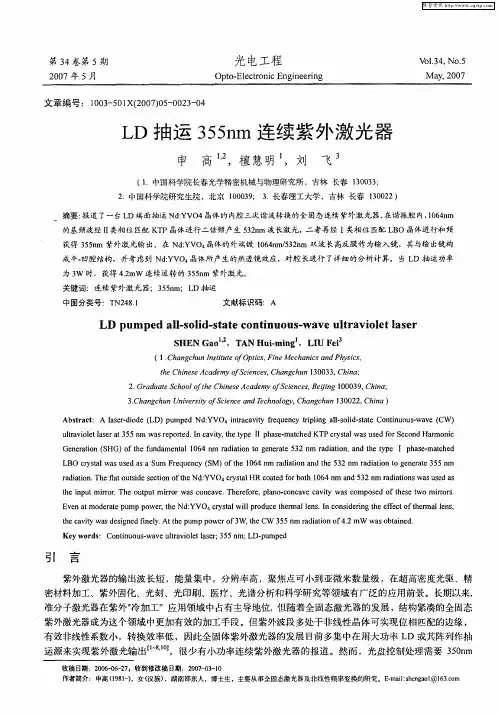
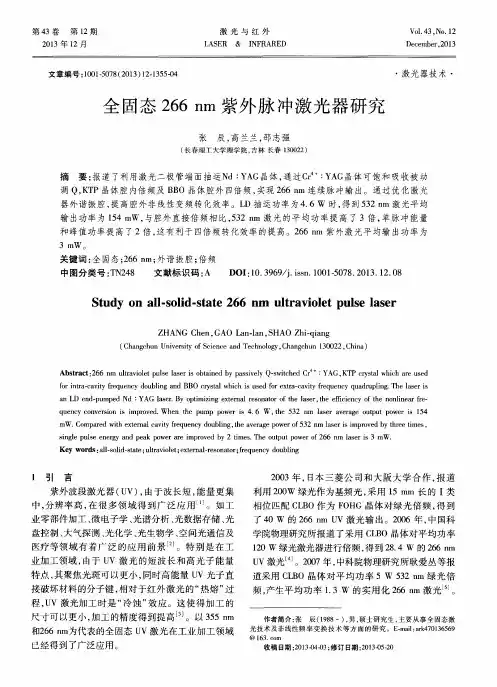
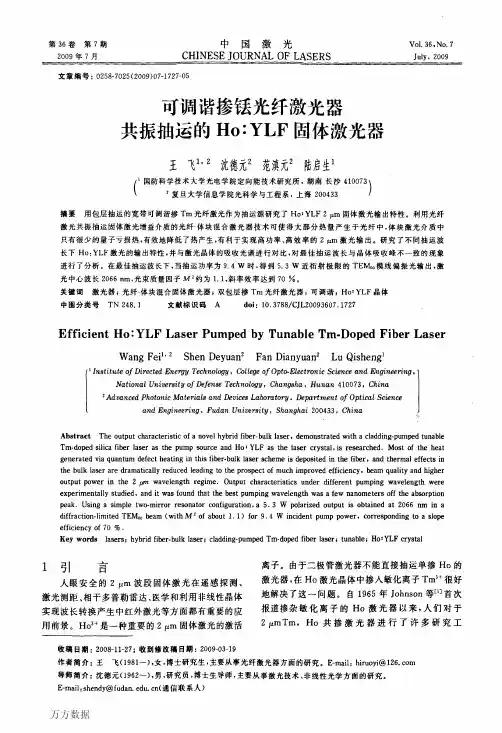
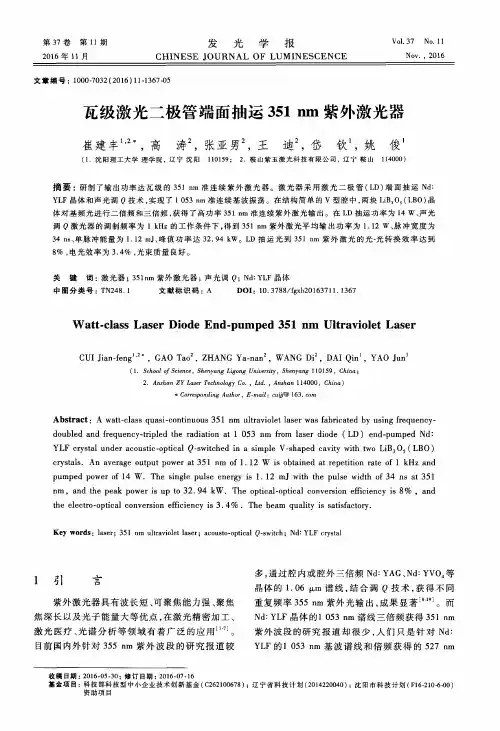
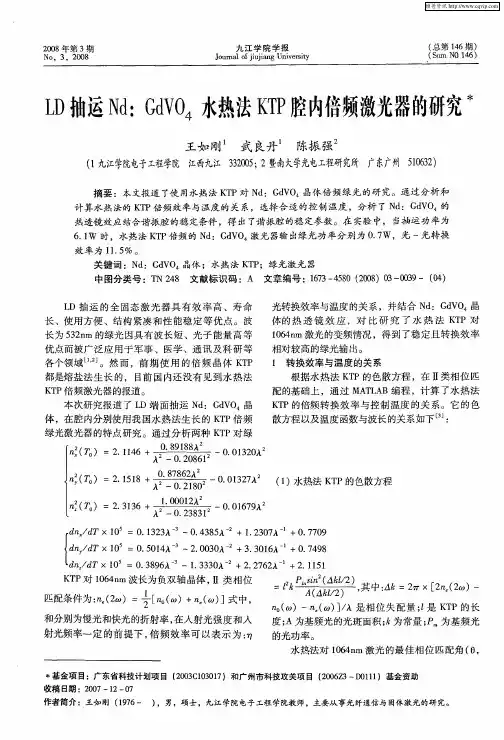
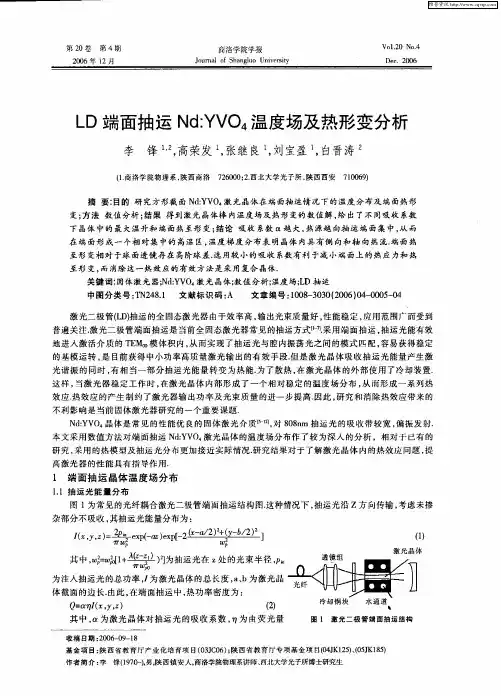
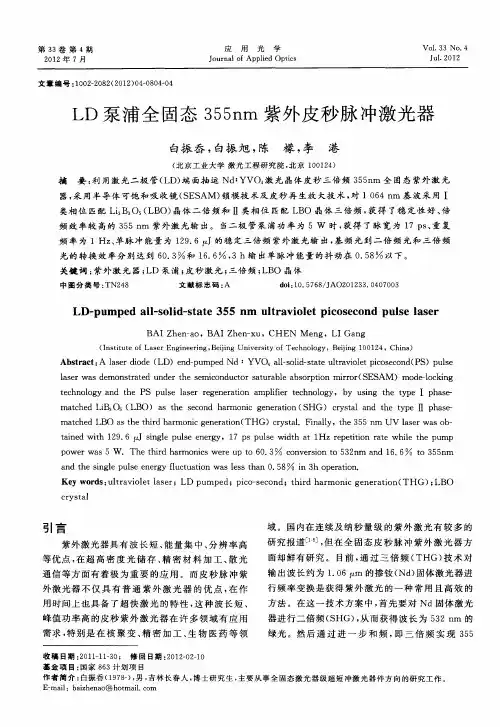
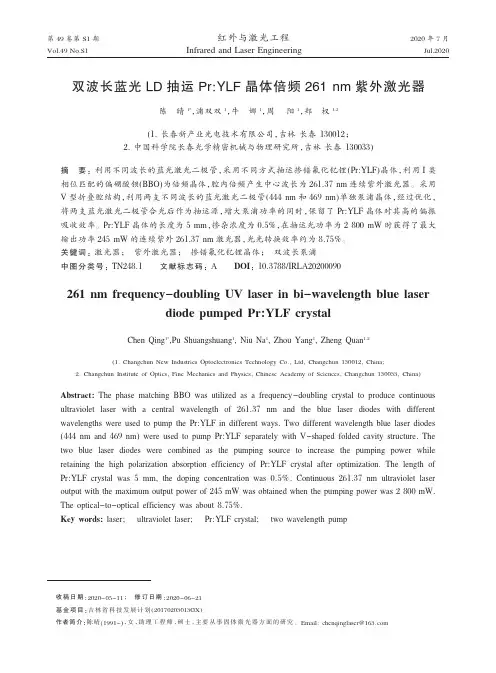
第49卷第S1期红外与激光工程2020年7月Vol.49No.S1Infrared and Laser Engineering Jul.2020双波长蓝光LD抽运Pr:YLF晶体倍频261nm紫外激光器陈晴1*,浦双双1,牛娜1,周阳1,郑权1,2(1.长春新产业光电技术有限公司,吉林长春130012;2.中国科学院长春光学精密机械与物理研究所,吉林长春130033)摘要:利用不同波长的蓝光激光二极管,采用不同方式抽运掺镨氟化钇锂(Pr:YLF)晶体,利用I类相位匹配的偏硼酸钡(BBO)为倍频晶体,腔内倍频产生中心波长为261.37nm连续紫外激光器。
采用V型折叠腔结构,利用两支不同波长的蓝光激光二极管(444nm和469nm)单独泵浦晶体,经过优化,将两支蓝光激光二极管合光后作为抽运源,增大泵浦功率的同时,保留了Pr:YLF晶体对其高的偏振吸收效率。
Pr:YLF晶体的长度为5mm,掺杂浓度为0.5%,在抽运光功率为2800mW时获得了最大输出功率245mW的连续紫外261.37nm激光器,光光转换效率约为8.75%。
关键词:激光器;紫外激光器;掺镨氟化钇锂晶体;双波长泵浦中图分类号:TN248.1文献标志码:A DOI:10.3788/IRLA20200090261nm frequency-doubling UV laser in bi-wavelength blue laserdiode pumped Pr:YLF crystalChen Qing1*,Pu Shuangshuang1,Niu Na1,Zhou Yang1,Zheng Quan1,2(1.Changchun New Industries Optoelectronics Technology Co.,Ltd,Changchun130012,China;2.Changchun Institute of Optics,Fine Mechanics and Physics,Chinese Academy of Sciences,Changchun130033,China)Abstract:The phase matching BBO was utilized as a frequency-doubling crystal to produce continuous ultraviolet laser with a central wavelength of261.37nm and the blue laser diodes with different wavelengths were used to pump the Pr:YLF in different ways.Two different wavelength blue laser diodes (444nm and469nm)were used to pump Pr:YLF separately with V-shaped folded cavity structure.The two blue laser diodes were combined as the pumping source to increase the pumping power while retaining the high polarization absorption efficiency of Pr:YLF crystal after optimization.The length of Pr:YLF crystal was5mm,the doping concentration was0.5%.Continuous261.37nm ultraviolet laser output with the maximum output power of245mW was obtained when the pumping power was2800mW.The optical-to-optical efficiency was about8.75%.Key words:laser;ultraviolet laser;Pr:YLF crystal;two wavelength pump收稿日期:2020-05-11;修订日期:2020-06-21基金项目:吉林省科技发展计划(20170203013GX)作者简介:陈晴(1991-),女,助理工程师,硕士,主要从事固体激光器方面的研究。
LD泵浦全固态紫外激光器张昕;杨军;吴国锋;鞠涛;李沼云【摘要】研究总结了激光二极管泵浦全固态紫外激光器的最新进展,为紫外激光器的研究提供了参考依据.主要从工作物质,非线性频率变换晶体和腔型结构等三个方面对激光二极管泵浦全固态紫外激光产生的关键技术进行了讨论,并简述其发展历史、现状及未来发展方向.%This paper realized the latest development of all-solid-state ultraviolet laser and provide guidance for the research. That discussed the key technology of LD-pumped all-solid-state ultraviolet laser, such as material crystals, nonlinear frequency-doubling crystal and configurations of resonator. And outlines the historyof it's development, current situation, and future development direction.【期刊名称】《光通信技术》【年(卷),期】2011(000)007【总页数】4页(P7-10)【关键词】激光二极管泵浦;全固态紫外激光器;倍频;增益介质【作者】张昕;杨军;吴国锋;鞠涛;李沼云【作者单位】中国电子科技集团公司,第三十四研究所,广西,桂林,541004;中国电子科技集团公司,第三十四研究所,广西,桂林,541004;中国电子科技集团公司,第三十四研究所,广西,桂林,541004;中国电子科技集团公司,第三十四研究所,广西,桂林,541004;中国电子科技集团公司,第三十四研究所,广西,桂林,541004【正文语种】中文【中图分类】TN248.40 引言1960年第一台全固态激光器诞生不久,由激光二极管泵浦的全固态激光器便在林肯实验室问世了。
LD端面抽运变导热系数Nd:YAG晶体热效应李隆;甘安生;齐兵;支音;王良甚;史彭【摘要】In order to calculate temperature field and thermal distortion field of laser diode end-pumped Nd:YAG crystal, the temperature thermal model of the crystal was built under the condition of thermal isolation of the end face and constant peripheral temperature. Based on the function of temperature of the Nd-YAG crystal depending upon the thermal conductivity and thermal distortion coefficient, after the thermal model of heat conduction equations were solved by means of the Newton tangent method, the general equations of the temperature field and thermal distortion field of the end-pumped rectangular cross section Nd-YAG crystal with variable thermal conductivity and thermal distortion coefficient were obtained. Then the internal temperature field distribution and thermal distortion field were calculated under different of pump power and pump spot size. Results show that under the condition of 0. 01 Nd ion mass fraction, 60W pump power and 450μm pump spot radius, the maximum temperature rise on the end face of the Nd:YAG crystal in 3mm × 3mm x 8mm was 55. 7℃ , and the maximum thermal distortion was 2. 85μm. However, traditionally the thermal conductivity and thermal distortion coefficient were taken as constant, the maximum temperature rise on the end face of the Nd-YAG crystal was 43. 4℃ and the maximum thermal distortion was 2. 84μm.%为了计算二极管抽运Nd∶ YAG晶体温度场及热形变场,建立了端面绝热、周边恒温的晶体热模型.基于Nd∶ YAG晶体导热系数及热形变系数与其温度的函数关系,应用Newton切线法对热传导方程进行求解,得到了变导热系数和变热形变系数矩形截面Nd∶YAG晶体端面抽运下的温度场和热形变场的一般表达式,同时计算了Nd∶ YAG晶体在不同抽运功率和抽运光斑半径下内部温度场和热形变场的分布变化.结果表明,使用钕离子质量分数为0.01、尺寸为3mm×3mm×8mm的Nd∶ YAG晶体,在功率为60W、光斑半径为450μm 的抽运光照射下,变导热系数的Nd∶ YAG晶体端面最大温升为55.7℃,最大热形变量为2.85μm,而按传统将Nd∶ YAG晶体导热系数、热形变系数均视为定值时,晶体端面最大温升为43.4℃,端面最大热形变为2.84μm.【期刊名称】《激光技术》【年(卷),期】2012(036)005【总页数】5页(P612-616)【关键词】激光器;热效应;固体激光器;Nd:YAG晶体;导热系数【作者】李隆;甘安生;齐兵;支音;王良甚;史彭【作者单位】西安建筑科技大学理学院,西安710055;西安建筑科技大学应用物理研究所,西安710055;西安建筑科技大学理学院,西安710055;西安建筑科技大学应用物理研究所,西安710055;西安建筑科技大学理学院,西安710055;西安建筑科技大学理学院,西安710055;西安建筑科技大学理学院,西安710055;西安建筑科技大学应用物理研究所,西安710055;西安建筑科技大学理学院,西安710055;西安建筑科技大学应用物理研究所,西安710055【正文语种】中文【中图分类】TN248.1引言Nd∶YAG晶体量子效率高、受激辐射截面大,其结构利于产生高增益、低阈值的激光,成为目前应用于激光二极管抽运全固态激光器(diode pump solid-state laser,DPSSL)较为广泛的晶体之一[1]。
固体紫外激光器原理一、概述固体紫外激光器是利用固体材料产生紫外激光的一种激光器。
其原理是通过激发固体材料中的活性离子或分子,使其跃迁到高能级,然后在受激辐射的作用下发射出紫外激光。
固体紫外激光器具有紫外光束质量好、光束稳定性高、脉冲宽度短等特点,广泛应用于光谱分析、材料加工、生物医学等领域。
二、固体材料选择固体紫外激光器的关键是选择适合的固体材料。
通常选择具有高能级跃迁能级的材料,如三氧化二铼、氟化氢钠、溴化锌等。
这些材料的能级跃迁能量与所需的紫外光能量匹配较好,能够有效地产生紫外激光。
三、能级跃迁过程固体紫外激光器的工作原理是通过能级跃迁过程来实现。
在固体材料中,活性离子或分子处于基态能级时,通过外界激发能量,使其跃迁到激发态能级。
然后,在受激辐射的作用下,激发态能级的活性离子或分子会发射出紫外激光,返回到基态能级。
这一过程是通过固体材料中的能级结构和激发源的作用来实现的。
四、激发源固体紫外激光器的激发源通常采用脉冲激光器。
脉冲激光器可以提供足够的能量,将固体材料中的活性离子或分子激发到激发态能级,从而产生紫外激光。
常用的脉冲激光器有Nd:YAG激光器、二极管激光器等。
这些激光器具有高能量、高功率、短脉冲宽度等优点,适合用于固体紫外激光器的激发源。
五、激光输出固体紫外激光器的激光输出通常是通过光学谐振腔来实现的。
光学谐振腔由输出镜和反射镜构成,能够将激发态能级发射的紫外激光进行反射和放大,形成激光输出。
输出镜通常具有高反射率,反射镜具有一定的透射率。
输出镜的反射率和反射镜的透射率可以根据需要进行调节,以控制激光的输出功率和波长。
六、应用领域固体紫外激光器具有紫外光束质量好、光束稳定性高、脉冲宽度短等特点,被广泛应用于光谱分析、材料加工、生物医学等领域。
在光谱分析中,固体紫外激光器可以用于荧光光谱、紫外吸收光谱等的检测。
在材料加工中,固体紫外激光器可以用于微细加工、激光打标等。
在生物医学中,固体紫外激光器可以用于细胞检测、组织成像等。
固体紫外激光器原理引言:固体紫外激光器是一种基于固体材料的紫外激光器,具有较短的波长和高能量密度,被广泛应用于生物医学、材料加工、光谱分析等领域。
本文将介绍固体紫外激光器的工作原理及其相关技术。
一、固体紫外激光器的基本原理固体紫外激光器采用固体材料作为激光介质,其工作原理基于激光的受激辐射效应。
当固体介质受到外界能量激发时,处于基态的固体分子将吸收能量,其中的电子被激发到激发态。
然后,这些激发态的电子通过非辐射跃迁或受激辐射跃迁回到基态,释放出辐射能量。
这种辐射能量就是激光光子。
二、固体紫外激光器的结构和组成固体紫外激光器一般由激光介质、泵浦源、谐振腔和输出耦合器等部分组成。
1. 激光介质固体紫外激光器的激光介质通常采用具有较高激发态寿命和宽放大带宽的固体材料,如Nd:YAG、Nd:YVO4等。
这些固体材料具有优异的光学性能和较高的热导率,能够实现高效能量转换和热量散射。
2. 泵浦源固体紫外激光器的泵浦源一般采用强泵浦光源,如激光二极管、氙灯等。
这些泵浦光源能够提供足够的能量,将固体介质激发到激发态。
3. 谐振腔谐振腔是固体紫外激光器中的一个重要组成部分,用于增强激光的放大和反射。
谐振腔通常由两个反射镜构成,其中一个镜子具有较高的反射率,另一个镜子具有较低的反射率。
4. 输出耦合器输出耦合器用于从谐振腔中耦合出激光输出。
输出耦合器通常由一个半透明镜组成,能够将一部分光线透过,而反射一部分光线。
三、固体紫外激光器的工作过程固体紫外激光器的工作过程通常包括泵浦、激光放大和激光输出三个阶段。
1. 泵浦泵浦阶段是通过外界能量激发固体介质的过程。
泵浦光源产生的泵浦光通过输入端进入激光介质,将固体介质中的电子激发到激发态。
2. 激光放大激光放大阶段是指激发态的电子通过受激辐射跃迁或非辐射跃迁回到基态的过程。
在这个过程中,激发态的电子释放出辐射能量,并引起固体介质中的其他电子跃迁,形成激光放大。
3. 激光输出激光输出阶段是指经过谐振腔增强和输出耦合器耦合后,激光从激光器中输出的过程。
1.57μm内腔式KTP光学参量振荡器钟艳;韩克祯;何京良【摘要】为了获得1.57μm人眼安全激光输出,采用了一种声光调Q激光二极管(LD)端面抽运的Nd ∶GdVO4全固态激光器作为抽运源的人眼安全波长内腔式KTP光学参量振荡器,获得1.57μm人眼安全激光输出。
在注入泵浦功率为6.33 W,重复频率为15 kHz时,1.57μm激光平均输出功率达到405 mW,此时由二极管注入泵浦光至OPO信号光输出功率的转换效率达6.4%;在重复频率为5 kHz时,其脉冲宽度约为2 ns,峰值功率达18.9 kW。
在重复频率为15 kHz时,信号光脉冲宽度比消耗后的泵浦光脉冲宽度压缩了13.6倍,比泵浦光脉冲压缩了16倍。
实验发现1.57μm的OPO信号光输出功率随脉冲重复频率的增加而有效地增加,此类光参量振荡器有效地压缩了激光脉冲。
%In order to obtain1.57μm eye safety laser output,an efficient intracavity optical parametric oscillator based on a KTP crystal inside an Q-switched Nd ∶GdVO4 laser end pumped by a fiber-coupled diode laser is adopted.In the acousto-optic Q-switched operation with the pulse repetition rate of 15kHz,the average power of 1.57μm eye-safe la-ser is 405mW at the incident pump power of 6.33W,and the conversion efficiency of the average power is6.4%from pump diode to OPO signal output.Under the pulse repetition rate of 5 kHz,the pulse width of 2 ns and peak power of 18.9 kW is achieved.The signal pulse duration is about 13.6 times shorter than that of the depleted pump light and it is about 16 times shorter than that of the pump light at a pulse repetition rate of 15 kHz.The experimental results show that the average power of 1.57μm OPO signal output increaseseffectively with the increase of pulse repetition fre-quency.This kind of optical parametric oscillator compresses the laser pulse effectively.【期刊名称】《激光与红外》【年(卷),期】2015(000)007【总页数】4页(P782-785)【关键词】激光技术;光参量振荡器(OPO);人眼安全波长;全固态激光器【作者】钟艳;韩克祯;何京良【作者单位】山东英才学院机械制造及自动化工程学院,山东济南250104;山东理工大学理学院,山东淄博255049;山东大学晶体材料研究所,山东济南250100【正文语种】中文【中图分类】TN248.1高重复频率、高峰值功率1.5~1.6 μm波段的人眼安全激光光源在大气污染遥测、激光水下通讯、相干激光雷达、人眼安全测距及成像等民用及军事领域都有重要应用[1-2]。